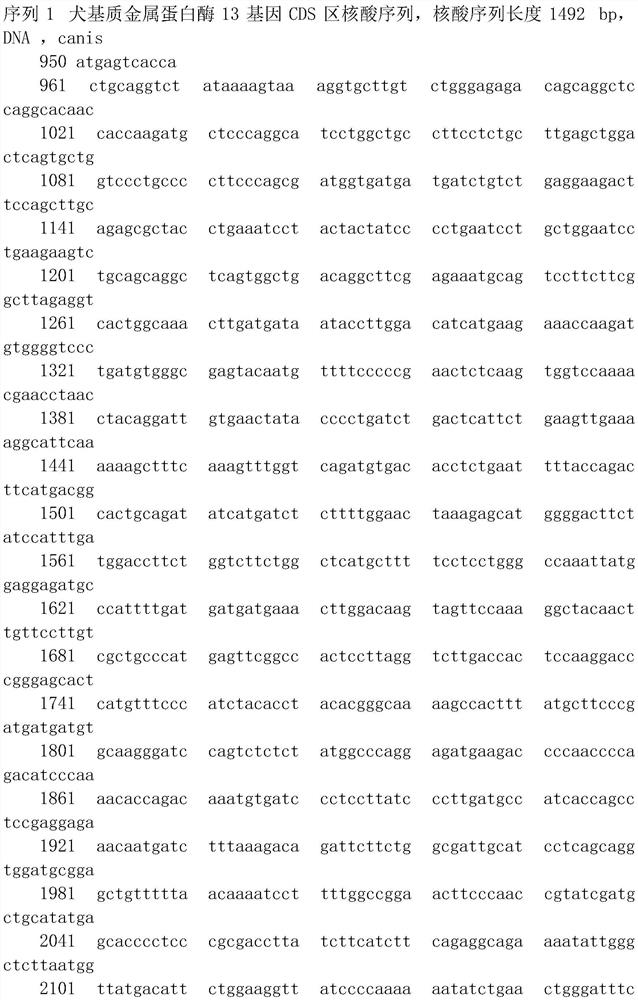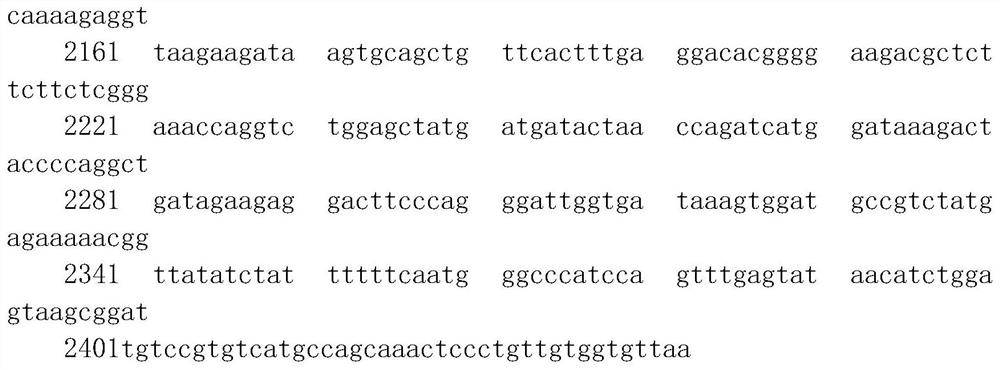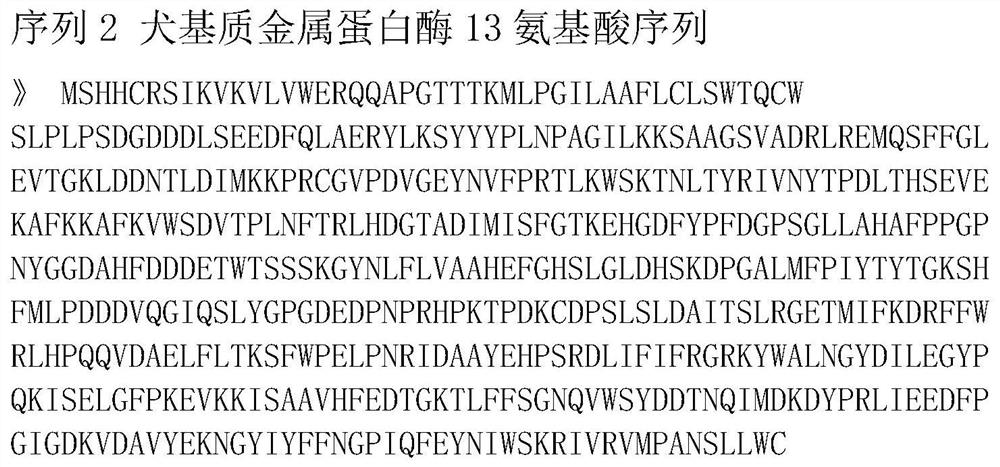Anti-canine matrix metalloproteinase hybridoma cell strain, preparation method of hybridoma cell strain, monoclonal antibody and application of monoclonal antibody
A technology of hybridoma cell lines and monoclonal antibodies, which is applied in the field of monoclonal antibodies, biotechnology-monoclonal antibodies, can solve the problems of no reports on the application of monoclonal antibodies to hybridoma cell lines, etc., and achieve good uniformity, High purity and strong specific effect
- Summary
- Abstract
- Description
- Claims
- Application Information
AI Technical Summary
Problems solved by technology
Method used
Image
Examples
Embodiment 1
[0064] Obtaining of canine recombinant matrix metalloproteinase (MMP-13).
[0065] The matrix metalloproteinase provided by the present invention as an antigen is RNA extracted from German shepherd dog knee articular cartilage tissue using genetic engineering technology, and the matrix metalloproteinase gene is obtained through reverse transcription and RT-PCR, then cloned into a plasmid, transformed After expression in Escherichia coli, the specific cloning and purification process is as follows:
[0066] 1) First, the matrix metalloproteinase gene was cloned and sequenced from German Shepherd dog knee articular cartilage tissue using conventional techniques. The specific conditions for reverse transcription and RT-PCR and the corresponding primer sequences are:
[0067] Upstream primers: GGAATTC ATGAGTCACCACTGCAGGTC is underlined as the Eco R1 site
[0068] Downstream primer: G CCTCGAG TTAACACCACAACAGGGAGT, underlined as Xho 1 site
[0069] Template cDNA synthesis after...
Embodiment 2
[0076] Production of canine MMP-13 monoclonal antibody hybridoma cell line and preparation of canine MMP-13 monoclonal antibody
[0077] 1) Antigen for immunization: MMP-13 of dogs obtained in step 2) of Example 1;
[0078] 2) Immunization procedure: BALB / c mice (purchased from the Animal Experiment Center of Huazhong Agricultural University) were used as immunized animals. The dose of antigen for the first immunization was 100 μg / mouse, injected subcutaneously at multiple points, and boosted immunized 4 times at intervals of 10-14 days , take splenocytes;
[0079] 3) Cell fusion: Myeloma cells SP 2 / 0 in the logarithmic growth phase and splenocytes were used for cell fusion in a solvent of polyethylene glycol (molecular weight 4000), in a medium containing HAT (H is the abbreviation of Hypoxanthine, A is the abbreviation of methotrexate Aminopterin, and T is the abbreviation of thymidine Thymidine) culture medium for selective cultivation;
[0080] 4) Hybridoma cell cloning:...
Embodiment 3
[0086] Indirect ELISA method was used to determine the optimum coating concentration of antigen.
[0087] 1) The antigen was diluted with coating buffer CBS (0.05mol carbonate buffer, pH 9.6) at a concentration of 1 μg / mL for a 1:2 ratio. Coat a row at every dilution and add enzyme at 100 μL / well In the target plate, the film was sealed (to prevent moisture evaporation) and coated overnight at 4°C.
[0088] 2) Shake off the liquid in the plate the next day, pat the plate dry on absorbent paper, add 150 μL of blocking solution (coating buffer CBS containing 1% BSA) to each well, and keep at room temperature for more than 2 hours.
[0089] Use the washing solution PBST (PBS containing 0.05% Tween-20, pH 7.4) to make serial 1:2 dilutions starting from 1:500, add 100 μL / well, and incubate at 37°C for 1 hour.
[0090] 3) Take it out and pat dry, wash the plate 3 times with washing solution, add 100 μL of secondary antibody working solution (dilute HRP-labeled goat anti-mouse IgG w...
PUM
 Login to View More
Login to View More Abstract
Description
Claims
Application Information
 Login to View More
Login to View More - R&D Engineer
- R&D Manager
- IP Professional
- Industry Leading Data Capabilities
- Powerful AI technology
- Patent DNA Extraction
Browse by: Latest US Patents, China's latest patents, Technical Efficacy Thesaurus, Application Domain, Technology Topic, Popular Technical Reports.
© 2024 PatSnap. All rights reserved.Legal|Privacy policy|Modern Slavery Act Transparency Statement|Sitemap|About US| Contact US: help@patsnap.com










